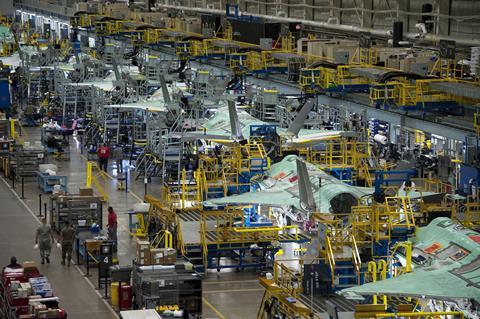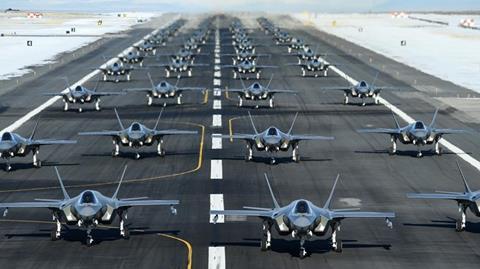The Lockheed Martin F-35 stealth fighter has reached what is typically a critical milestone in the life cycle of major defence programmes – but the significance may be more symbolic than substantial.
The Pentagon on 12 March said it approved Lockheed’s F-35 programme for full-rate production, an event known as “Milestone C” in the bureaucratic language of US Department of Defense acquisitions.
“This is a major achievement for the F-35 programme,” says US under secretary of defense for acquisition and sustainment William LaPlante.
The Pentagon’s top procurement official describes reaching Milestone C as signalling to the US military and overseas customers that F-35s are ready for operational deployment, and that industry is capable of fully supporting production and sustainment.
“The F-35 programme is the premier system that drives interoperability with our allies and partners while contributing to the integrated deterrence component of our national defence strategy,” LaPlante says.

Full-rate production is normally an immensely important juncture for defence production programmes. After years of low-margin or even loss-generating engineering and initial production contracts, full-rate production status typically brings more orders, long-term sustainment contracts and better margins.
However, in the case of the F-35, the distinction may be largely immaterial.
Lockheed is already producing F-35s at its maximum output, producing 156 of the jets annually. The company has delivered more than 990 of the single-engined fighters and in January completed assembly of the 1,000th example.
Globally, F-35s are already operated by 14 military services in nine countries. Twelve of those services have already declared initial operational capability on their F-35 fleets – signifying at least a minimum ability to sustain and deploy the fighter operationally.
Across those operators, the worldwide F-35 fleet has logged more than 811,000 flight hours during some 486,000 individual sorties, according to Lockheed.
In light of those figures, the Pentagon’s declaration of Milestone C appears to be more an acknowledgement of reality than the transition into large-scale production it typically signifies.

US defence officials had previously hoped to announce the Milestone C decision in 2019, but technical issues related to integrating the F-35 programme into a Pentagon simulation system delayed the move. Pentagon programme officials now reveal that simulated missions were successfully completed in September 2023, paving the way for LaPlante to approve full-rate production.
Lieutenant General Mike Schmidt, the top officer overseeing F-35 development and procurement, praises recent developments in the enterprise, which has for years battled massive cost overruns, technical challenges and limited aircraft availability.
“The F-35 enterprise has made significant improvements over the last decade, and we will always be driven to continuously improve sustainability, interoperability and lethality, so war fighters have the capability needed to fight and win,” Schmidt says.
The lack of full-rate production authorisation has not prevented F-35 orders from pouring in to Lockheed. Singapore in February added eight F-35Bs to its existing programme, while US arms regulators in January approved a request from Greece covering 40 F-35As. Multiple other countries signed on to the F-35 programme in recent years, including Canada, Finland, Germany, Poland and Switzerland.
Eighteen nations have now committed to operating the stealth fighter.
The Pentagon is not currently accepting any new F-35 deliveries in the TR-3 standard, as Lockheed works to complete flight certification on the latest configuration of the fighter. That package includes new hardware and software that will allow future upgrades to weapons, communications and onboard sensors.
Lockheed tells FlightGlobal the company expects to deliver between 75 and 110 F-35s in 2024.


























